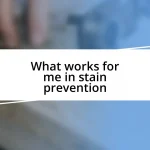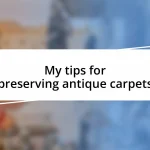Key takeaways:
- Understanding the type of stain and fabric is crucial for effective treatment, with different methods required for materials like cotton, silk, and denim.
- Homemade stain removers using common household ingredients, such as baking soda and vinegar, are effective and environmentally friendly solutions.
- Prevent future stains by covering surfaces, wearing dedicated “craft clothes,” and choosing washable materials for crafting projects.

Understanding Common Craft Stains
When diving into arts and crafts, it’s almost inevitable that you’ll encounter a stain or two. I still remember the first time I splattered acrylic paint on my favorite shirt – the frustration was real! This experience taught me firsthand that understanding the types of stains we’re dealing with can make all the difference in treatment and prevention.
Craft stains can come from a variety of sources, such as paint, glue, or markers, and each one has its own quirks. For instance, my attempts at watercolors often left me with splotchy stains that didn’t seem to budge. I found out that water-based stains respond better to soap and water, which is a little relief when panic sets in. But what about oil-based stains? I learned through trial and error that they often called for more robust cleaners, leaving me wishing I had a few more tricks up my sleeve.
As I experimented with different materials, I started to realize that some stains can even tell a story. A smear of blue paint on my hands might be a reminder of a joyful day spent creating with friends. This emotional attachment makes stain management feel personal, prompting questions like: How can I ensure these messy moments of creativity don’t leave permanent marks? The answer lies in proactive care and an understanding of how different substances interact with fabrics.

How to Treat Different Fabrics
Treating stains effectively begins with understanding the fabric itself. For example, I learned the hard way that cotton is typically much more forgiving than silk. Once, after a particularly exhilarating acrylic paint session, I quickly dabbed a cotton t-shirt with soap and water. To my delight, the paint lifted right away! However, I wouldn’t dare use the same method on silk; that delicate fabric often requires a gentler touch, like a specialized silk cleaner, to avoid damaging it.
When it comes to denim, another fabric I adore, I found a unique solution: rubbing alcohol. This came in handy when a rogue splash of fabric dye marred my favorite jeans. After soaking a cotton ball with the alcohol and gently dabbing at the stained area, I noticed the stain soften and lighten. I was ecstatic to reclaim my beloved pair, which brought back fond memories of a summer picnic. On the flip side, treating wool can be quite tricky; I prefer to use a mild detergent and work gently to avoid felting.
You might wonder how to manage blends like polyester and cotton. From my experience, these fabrics can typically handle a bit more aggressive cleaning, but I’d still recommend a gentle cycle in the washing machine. Mixed fabrics often need a customized approach, depending on the dye and paint types. I recall a time when my multi-colored apron took on a life of its own during a messy crafting session, and carefully unraveling that colorful chaos felt like solving a delightful puzzle.
| Fabric | Treatment Method |
|---|---|
| Cotton | Soap and water |
| Silk | Specialized silk cleaner |
| Denim | Rubbing alcohol |
| Wool | Mild detergent (gentle approach) |
| Polyester/Cotton Blend | Gentle cycle in washing machine |

Effective Homemade Stain Removers
I’ve found that homemade stain removers are not only effective but also easy to whip up with ingredients I usually have around the house. For example, a simple paste made from baking soda and water works wonders on those stubborn glue stains. I vividly recall a day when I accidentally spilled wood glue on my craft table. Armed with my baking soda paste, I watched the stain dissolve before my eyes, feeling a surge of relief.
Here’s a list of some favorite homemade stain removers you might want to try:
- Baking Soda Paste: Combine baking soda with water to form a paste for a wide range of stains.
- Vinegar Solution: Mix equal parts white vinegar and water; it works great on ink or marker stains.
- Dish Soap and Hydrogen Peroxide: A mix of these two can tackle grease or paint stains effectively.
- Salt and Lemon Juice: This combo works well on fresh stains, particularly for fabrics like cotton.
- Cornstarch: Sprinkle it on oil-based stains, let it sit to absorb the oil, and then vacuum it up.
There’s something so satisfying about creating these natural solutions. One day, after a spirited paint session with my daughter, I found myself in a colorful catastrophe—paint splatters everywhere! As I grabbed the vinegar solution, I felt empowered, knowing I could reclaim our crafting space without resorting to harsh chemicals. It made me appreciate how quickly I could solve these little mishaps with a bit of creativity and care.

Tips for Preventing Future Stains
When diving into arts and crafts, I’ve learned to make prevention a priority. One effective strategy is to always cover surfaces with old newspapers or drop cloths. I remember the moment I realized this simple step could save me countless hours of cleaning—a splash of paint on my new dining table was all the motivation I needed! It’s funny how one tiny accident can lead to such a proactive habit.
Another tip I cherish is the art of dressing for the occasion. I now reserve specific “craft clothes” that I don’t mind getting stained. Initially, I stuck to my favorite outfits, but one day, a vibrant ink mishap made me rethink my approach. Now, I wear older tees or aprons whenever I unleash my creativity, and it’s liberating to know that I can fully enjoy the process without worrying about my wardrobe.
Lastly, consider choosing wash-resistant materials for your projects. I often opt for acrylic paints and markers labeled as “washable.” During a particularly chaotic project with my kids, I was pleasantly surprised to discover that the washable paint kept our clothes looking pristine, despite our enthusiasm. Why risk a permanent mess when there are so many options that allow for creativity without the long-lasting stains? Embracing these small changes can truly transform the crafting experience!














